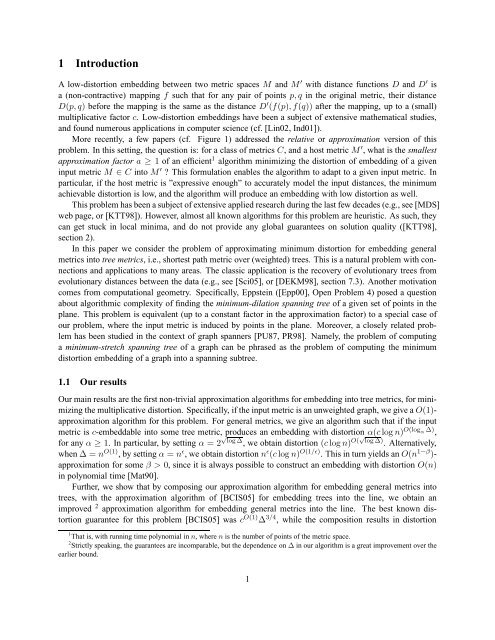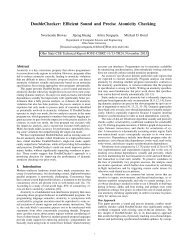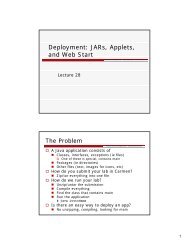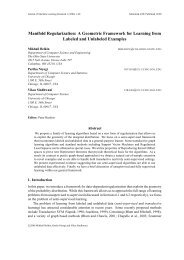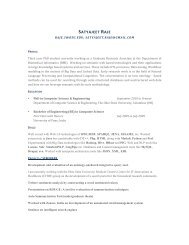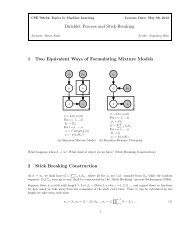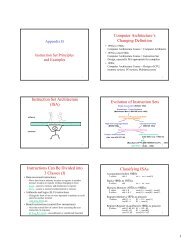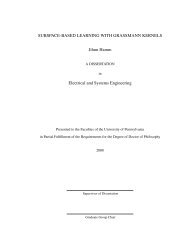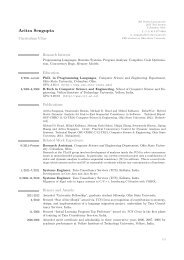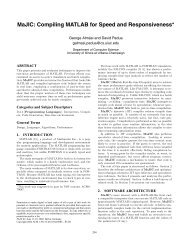Approximation Algorithms for Embedding General Metrics Into Trees
Approximation Algorithms for Embedding General Metrics Into Trees
Approximation Algorithms for Embedding General Metrics Into Trees
Create successful ePaper yourself
Turn your PDF publications into a flip-book with our unique Google optimized e-Paper software.
1 Introduction<br />
A low-distortion embedding between two metric spaces M and M ′ with distance functions D and D ′ is<br />
a (non-contractive) mapping f such that <strong>for</strong> any pair of points p,q in the original metric, their distance<br />
D(p,q) be<strong>for</strong>e the mapping is the same as the distance D ′ (f(p),f(q)) after the mapping, up to a (small)<br />
multiplicative factor c. Low-distortion embeddings have been a subject of extensive mathematical studies,<br />
and found numerous applications in computer science (cf. [Lin02, Ind01]).<br />
More recently, a few papers (cf. Figure 1) addressed the relative or approximation version of this<br />
problem. In this setting, the question is: <strong>for</strong> a class of metrics C, and a host metric M ′ , what is the smallest<br />
approximation factor a ≥ 1 of an efficient 1 algorithm minimizing the distortion of embedding of a given<br />
input metric M ∈ C into M ′ ? This <strong>for</strong>mulation enables the algorithm to adapt to a given input metric. In<br />
particular, if the host metric is ”expressive enough” to accurately model the input distances, the minimum<br />
achievable distortion is low, and the algorithm will produce an embedding with low distortion as well.<br />
This problem has been a subject of extensive applied research during the last few decades (e.g., see [MDS]<br />
web page, or [KTT98]). However, almost all known algorithms <strong>for</strong> this problem are heuristic. As such, they<br />
can get stuck in local minima, and do not provide any global guarantees on solution quality ([KTT98],<br />
section 2).<br />
In this paper we consider the problem of approximating minimum distortion <strong>for</strong> embedding general<br />
metrics into tree metrics, i.e., shortest path metric over (weighted) trees. This is a natural problem with connections<br />
and applications to many areas. The classic application is the recovery of evolutionary trees from<br />
evolutionary distances between the data (e.g., see [Sci05], or [DEKM98], section 7.3). Another motivation<br />
comes from computational geometry. Specifically, Eppstein ([Epp00], Open Problem 4) posed a question<br />
about algorithmic complexity of finding the minimum-dilation spanning tree of a given set of points in the<br />
plane. This problem is equivalent (up to a constant factor in the approximation factor) to a special case of<br />
our problem, where the input metric is induced by points in the plane. Moreover, a closely related problem<br />
has been studied in the context of graph spanners [PU87, PR98]. Namely, the problem of computing<br />
a minimum-stretch spanning tree of a graph can be phrased as the problem of computing the minimum<br />
distortion embedding of a graph into a spanning subtree.<br />
1.1 Our results<br />
Our main results are the first non-trivial approximation algorithms <strong>for</strong> embedding into tree metrics, <strong>for</strong> minimizing<br />
the multiplicative distortion. Specifically, if the input metric is an unweighted graph, we give a O(1)-<br />
approximation algorithm <strong>for</strong> this problem. For general metrics, we give an algorithm such that if the input<br />
metric is c-embeddable into some tree metric, produces an embedding with distortion α(clog n) O(log α ∆) ,<br />
<strong>for</strong> any α ≥ 1. In particular, by setting α = 2 √ log ∆ , we obtain distortion (clog n) O(√ log ∆) . Alternatively,<br />
when ∆ = n O(1) , by setting α = n ǫ , we obtain distortion n ǫ (clog n) O(1/ǫ) . This in turn yields an O(n 1−β )-<br />
approximation <strong>for</strong> some β > 0, since it is always possible to construct an embedding with distortion O(n)<br />
in polynomial time [Mat90].<br />
Further, we show that by composing our approximation algorithm <strong>for</strong> embedding general metrics into<br />
trees, with the approximation algorithm of [BCIS05] <strong>for</strong> embedding trees into the line, we obtain an<br />
improved 2 approximation algorithm <strong>for</strong> embedding general metrics into the line. The best known distortion<br />
guarantee <strong>for</strong> this problem [BCIS05] was c O(1) ∆ 3/4 , while the composition results in distortion<br />
1 That is, with running time polynomial in n, where n is the number of points of the metric space.<br />
2 Strictly speaking, the guarantees are incomparable, but the dependence on ∆ in our algorithm is a great improvement over the<br />
earlier bound.<br />
1


